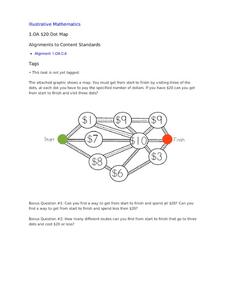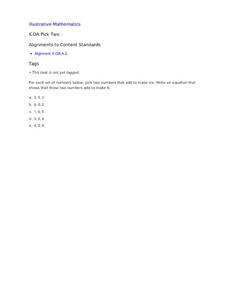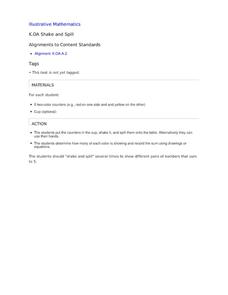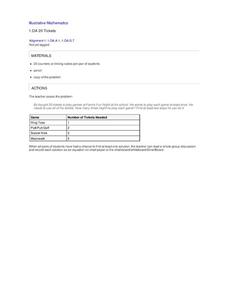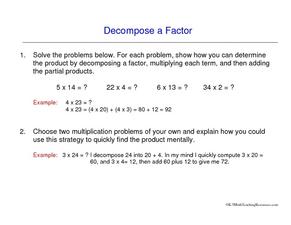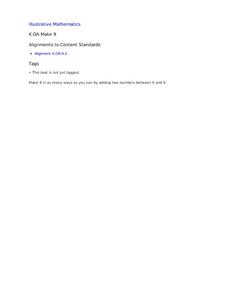Illustrative Mathematics
Equality Number Sentences
Understanding the concept of equality is fundamental to the success of young mathematicians. To explore this basic idea, children compare the dots arranged in pairs of rectangles in order to determine whether or not they contain an equal...
Illustrative Mathematics
$20 Dot Map
Challenge the addition skills of young learners with this open-ended math problem. The task is simple, get from start to finish by connecting a series of three numbers. The trick is that the sum of the numbers must be less than...
Illustrative Mathematics
Kiri's Mathematics Match Game
Learning math is so much more fun when it involves playing games. Following the rules of the classic game Memory, young mathematicians flip over two cards at a time as they look for numbers whose sum or difference is equal to the value...
Illustrative Mathematics
Christina's Candies
Help Christina figure out how many chocolate and lemon candies she has with a instructional activity on decomposing numbers. When presenting this context to the class, the teacher chooses the total number of candies and the number that...
Illustrative Mathematics
Pick Two
Learning to break apart numbers into smaller pairs is a critical step young mathematicians take as they develop their number sense. To practice this skill, children are provided with sets of three numbers and are asked to pick the two...
Illustrative Mathematics
Shake and Spill
Entertaining as well as educational, this math activity about decomposing numbers is bound to capture the engagement of young learners. Given a cup and five two-color counters, young mathematicians simply shake and spill the cup,...
Curated OER
20 Tickets
A great hands-on activity involving adding and subtracting, beginner mathematicians determine how many games can be played with 20 tickets. Instead of tickets, youngsters use 20 counters or linking cubes to represent the amount of...
Curated OER
Mixed Tables
How many pennies does each person get? There are four visual division problems for young mathematicians to solve, and they divide 12 pennies among a set of people for each. They draw the coins above each recipient and then write the...
Curated OER
Special Symbols
Bridge the gap between the term "take away" and the actual subtraction symbol using these illustrated practice problems. For each, youngsters see the number sentence in three ways: images of birds on twigs, written out in word form, and...
Curated OER
Fact Families
With a few extra numbers, these fact families would be complete! After looking at an example, scholars write in the sums and differences for six equations as part of three different fact families. This is really for beginners to this...
Curated OER
And 5 More Makes...
By drawing five more objects to existing sets, scholars begin to understand the concept of addition. They count pails and draw five more, totaling them and recording the sums. There are three of these followed by four more similar...
DK Publishing
Eggs in a Nest - Dividing by 2
How can each set of eggs be divided between two nests? Practice dividing by two as scholars examine seven nests and write number sentences to represent each. Each nest has an even number of eggs, so they always divide evenly. The largest...
Curated OER
Adding Dice
Roll the dice! These addition number sentences are for beginning mathematicians, and each addend is displayed on a die. Learners add up two or three single-digit addends to find eight sums in the first half of this learning exercise....
Curated OER
Adding Animals
Writing equations from images helps young mathematicians grasp addition, especially when they get to look at cute animals as they do it. There are six number sentences here, each illustrated with a set of animals corresponding to...
Curated OER
Adding Up
Make addition visual in order to help beginners understand the concept. They add up beads on a string, examining an example before trying it on their own. Learners fill in addends and sums for these, and sometimes both....
DK Publishing
3 Times Table
This 25-chart will give mathematicians a chance to detect patterns as they shade in every multiple of three by skip counting. They solve multiplication number sentences involving three and the numbers 1-5 (one is done for them.) Finally,...
Curated OER
What Does The Picture Say? (Addition Sentences)
A picture says a thousand words...or is it five? Have students represent sets of images numerically in number sentences. They examine three sets of images and represent them numerically by writing the number sentence below. While they...
Curated OER
Number Lines and Whole Numbers
Number lines are a great way to help scholars grasp basic addition when it's still a new concept. This worksheet offers them 10 chances to practice this association. The first five have an addition equation and a number line; learners...
Curated OER
Decompose a Factor
Mental multiplication just got easier! Clue your class into this multiplication shortcut as they decompose factors and add smaller products. For the first set of problems, they read the instructions, view an example, and then break down...
Curated OER
Facts of Five
This is a great math station partner game! Using the provided ten-frame cards, learners practice creating addition problems with a sum of 5. Each card has a number between 0 and 5, and pairs shuffle and lay out five of them. They take...
Curated OER
Match the Number Sentence!
Matching number sentences to their visual equivalents may seem easy, but there is a trick here to keep your learners thinking about math properties. As they examine the numerical forms of six addition problems, they must...
Curated OER
Combinations to 20
Ten frames are a great way to help visualize simple math problems, evidenced in this clear and concise word problems worksheet. Each question features two ten frames for learners to use as they solve. All numbers are 20 or less....
Curated OER
Turn Around Dominoes
Create simple addition number sentences using dominoes. Young scholars choose a domino and draw the dots on a template. Beneath their drawing, they write the addition sentence. Then, they "flip" the domino and write the "turn around...
Illustrative Mathematics
Make 9
Learning how numbers are put together as parts and wholes is a big step in building the foundational number sense of young mathematicians. Here, children are given a number less than 10 and are asked to find as many pairs of numbers as...



